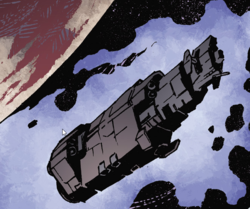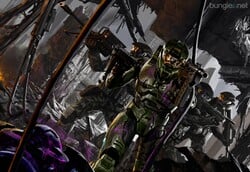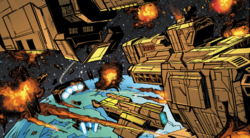UNSC Naval Command
From Halopedia, the Halo wiki
| UNSC Naval Command | |
|---|---|
|
Affiliation: |
|
|
Branch: |
|
|
Type: |
|
|
Role: |
Naval and space-based operations[1] |
The UNSC Naval Command (NAVCOM, or NavCom) is a unified combatant command of the United Nations Space Command responsible for all space-based assets and operations, while the Unified Ground Command has authority over terrestrial and close-orbit assets. All assets of the UNSC fall under one of these commands, which work closely together for joint operations.[1] Naval Command is directly subordinate to UNSC High Command.[2]
NAVCOM predominantly holds authority over the UNSC Navy and Office of Naval Intelligence alongside select elements of the UNSC Marine Corps for space-based operations.[3] However, representatives from all of the UNSC's military branches serve in joint-leadership and committee appointment within the organisation.[4]
History[edit]
During the United Nations Space Command's formative years, the Naval Command and the Unified Ground Command were limited within the Sol system. As the Unified Earth Government developed slipstream space technology and numerous colonies were established beyond Sol, Naval Command and Ground Command believed that their resources were better spent on activities within the Sol system, while the recently established Colonial Military Authority dealt with military affairs within the interstellar colonies.[5]
However, as the Inner Colonies grew and became more vital to the Unified Earth Government, NavCom and UniCom sought to disband the Colonial Military and attempted to usurp their role on a variety of occasions; the CMA charter—approved by the UNSC—gave the organization little room for external maneuvering. However, by the dawn of the 25th century, the Colonial Military Administration continued to operate alongside Naval Command and Ground Command within the Inner Colonies. Ultimately, the Colonial Military moved its domain to the emerging Outer Colonies.[5] When the Colonial Military Administration's involvement with the insurrectionists became public in 2497, the UEG began shifting the CMA's resources to NavCom and UniCom control.[6][7]
In 2525, with the beginning of the Human-Covenant War, all UEG combat forces were placed under the authority of the Naval Command or Unified Ground Command, including the CMA, for the "duration of the crisis".[5][8][7] In 2535, after Vice Admiral Preston Cole developed the Cole Protocol to help prevent the Covenant from locating Earth and other human colonies, with H. T. Ward issuing the directive out to all UNSC forces.[9][10]
Organization[edit]
Structure[edit]

Directly subordinate to UNSC High Command, Naval Command maintains a dual chain of command. Commanders report to NAVCOM for administrative issues, while operationally they report to their given Task Command. There are three main Task Commands within Naval Command:[4]
- Fleet Command (FLEETCOM) is the primary operational command of naval forces and has oversight of ship deployment, mission structures, and space operations, including the transport of troops and naval fighter operations.[11] Fleet Command is dominated by the UNSC Navy, with token representation by the UNSC Marine Corps.[12]
- Naval Logistical Operations Command (NAVLOGCOM) oversees the construction, maintenance, and distribution of supplies and materiél, including ships, ammunition, replacement parts, and food.
- Naval Special Warfare Command (NAVSPECWAR) —alongside its subordinate Naval Special Weapons (NAVSPECWEP)—is a member of the greater UNSC Special Forces community and is responsible for all naval special operations, including deployments of Spartans and Orbital Drop Shock Troopers. While Naval Special Weapons is technically under the joint authority of both Naval Command and the Unified Ground Command, in practice, UNICOM has primary oversight of special warfare troops in the field.[11]
Under the authority of the UNSC Navy, the Office of Naval Intelligence serves as the Naval Command's primary analysis arm, though the agency receives many orders and directives from High Command or even higher offices.[5] ONI has since absorbed most intelligence agencies of the Unified Earth Government and operates nearly autonomously, however ONI is still officially under NavCom's command.[12][13] However, ONI's operations often blindside NavCom's senior officers, leading to a borderline hostile relationship between ONI and Naval Command's upper echelons.[5]
In 2497, after the Colonial Military Authority's involvement with the insurrectionists went public, the Unified Earth Government began shifting the CMA's resources to Naval Command and the Unified Ground Command.[6] The CMA was formally placed under the joint authority of the NavCom and UniCom in 2525, with the beginning of the Human-Covenant War. By 2552, the CMA had been relegated to menial duties.[5]
Operating forces[edit]

Naval Command is responsible for organizing warships and their associated support assets into battle groups, which are themselves combined into fleets.[1] These fleets are organized into numbered expeditionary fleets and named defense fleets. Battle groups serve as flexible fighting organizations that can be "plugged together" into ad hoc task forces. Ships may be enrolled into squadrons that fulfill attack, battle, carrier, monitor, and support functions, though became largely administrative units during the Human-Covenant War as fleet assets dwindled.[12] The largest and most powerful component of any Naval Command grouping, Fleet Command is directly responsible for the organization of Naval Command's operating forces.[1][4]
Naval Command and Unified Ground Command joint task forces are assigned to one of four Central Command regions, which are responsible for the defense and security of a specific area of human space. Forces assigned to one Central Command region cannot be moved to another without the approval of High Command.[1] As operatives of Spartan Operations are members of the Special Forces community, Spartans may be organized under Naval Special Warfare Command (or its UNICOM equivalent, Unified Special Warfare Command) during deployments, though Central Command is responsible for the allocation of Spartans to fleets.[14][15]
List of appearances[edit]
- Halo: The Fall of Reach (First appearance)
- Halo: The Cole Protocol (Mentioned only)
- Halo Wars (Mentioned only)
- Halo: Evolutions - Essential Tales of the Halo Universe
- Dirt (Mentioned only)
- The Impossible Life and the Possible Death of Preston J. Cole
- Halo: Official Spartan Field Manual
Sources[edit]
- ^ a b c d e f g h Halo: Official Spartan Field Manual - 08: UNSC Organization, page 118-143
- ^ Halo Encyclopedia (2011 edition), page 47
- ^ Halo Encyclopedia (2022 edition), page 56
- ^ a b c d e f Halo Encyclopedia (2011 edition), page 69
- ^ a b Halo Encyclopedia (2011 edition), page 34
- ^ a b Halo Encyclopedia (2022 edition), page 54-55
- ^ Halo Wars, Timeline Events: November 1, 2525
- ^ Halo: The Fall of Reach, chapter 15
- ^ Halo: The Cole Protocol, chapter 2
- ^ a b Halo Encyclopedia (2011 edition), page 64-65
- ^ a b c Halo: Fleet Battles: core rulebook page 6
- ^ Halo Encyclopedia (2022 edition), page 63
- ^ Halo: Official Spartan Field Manual - 02: The Spartan Way, page 18-35
- ^ Halo Encyclopedia (2022 edition), page 74
